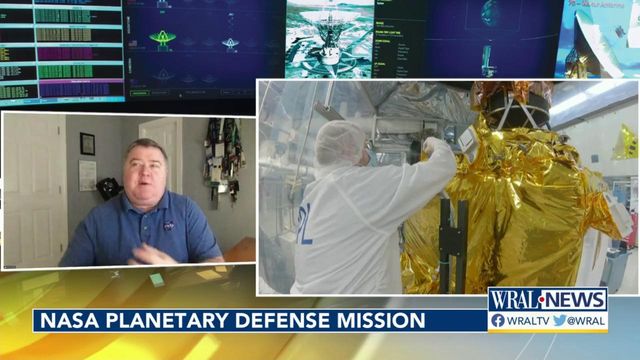NASA test launching this week will see if we can divert an on-coming asteroid
NASA is preparing the launch of science fact mission to address the small -- but real and preventable -- threat of a dangerous asteroid on a course to hit Earth.
Posted — UpdatedWhen an asteroid threatened Earth in the 1998 film Armageddon, Michael Bay sent a team of deep-core oil drillers. But that's science fiction's version of planetary defense from a movie known for getting the physics wrong at nearly every opportunity.
NASA is preparing the launch of science fact mission to address the small — but real and preventable — threat of a dangerous asteroid on a course to hit Earth. The Double Asteroid Redirection Test (DART) will demonstrate technologies to change the trajectory of a PHA, NASA speak for potentially hazardous asteroid.
DART’s target is a pair of asteroids about 479 million miles away. Didymos is about a half-mile across and its small companion moonlet, Dimorphos (though it's nickname of Didymoon is a lot more fun to say), is 530 feet across. Neither is a threat to Earth but provide an ideal place to test ideas on how to prepare for future ones.
Andy Rivkin, co-lead investigator for the mission, describes the solution DART is testing to the problem of an asteroid on a collision course: "You can't change the speed of the Earth, so the idea would be to change the speed of the impactor."
DART is expected to reach the asteroids in late September of 2022. Cameras onboard, similar to those aboard the New Horizons mission to Pluto, will return images of Didymos and Dimorphos to researchers about once per second.
How it works
About five days before the big event, DART will release the Light Italian CubeSat for Imaging of Asteroids. LICIACube will be deployed to capture the event with its cameras dubbed LUKE and LEIA, (LICIACube Unit Key Explorer and LICIACube Explorer Imaging for Asteroid).
DART will then ram into little Dimorphos at a speed of about 4 miles per second. The washing machine sized spacecraft won't do much damage to the Washington-monument-sized space rock, but it will slow it down. Small changes in speed, when made early enough, add up to big changes in trajectory by the time an object is closer to Earth.
Those changes will be monitored by LICIACube as well as telescopes and radars back on Earth.
Mission firsts
- smallest object targeted by a spacecraft
- first deep-space use of Roll-Out Solar Arrays (ROSA)
- first use of the NEXT–C engine which uses electricity to accelerate xenon propellant up to 90,000 miles per hour
The launch is planned aboard a SpaceX Falcon 9 rocket from Vandenberg Space Force Base in California on Tuesday night 10:20 p.m. local time (1:20 a.m. EST Thursday morning for those of us on the east coast).
• Credits
Copyright 2024 by Capitol Broadcasting Company. All rights reserved. This material may not be published, broadcast, rewritten or redistributed.





